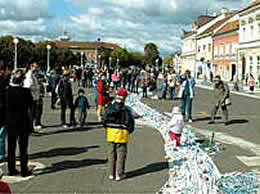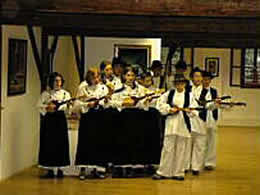 |
| Impressions from the Drava Day held in Spetember 2002 in Koprivnica (Croatia) |
With about 250 km of almost untouched riverine landscape, rich in wildlife,
many unspoiled habitats and high biodiversity, the Hungary–Croatia
stretch of the Drava is the most natural and fascinating section of this
beautiful transboundary river. This stretch of the river is surrounded by
lush riparian forests, mysterious dark green backwaters, and a dynamic river
system creating river islands and shingle bars, and eroding cliffs. The
border between the two countries is itself extraordinary.
It was established one thousand years ago along the river’s course,
and has remained unchanged even as the river changed course. As a result,
there are patches of Croatian territory on the Hungarian bank, and Hungarian
enclaves on the Croatian side. During the decades of communism, the river
corridor was heavily defended and inaccessible. In the absence of human
interference, nature thrived. One can still travel long distances downriver
without seeing a single building. The challenge now is to conserve the rich
natural heritage which has survived—and the mosaic of diverse cultural
expression it shaped—in the face of rapid, often inappropriate, economic
development.
On the Hungarian side, the Danube–Drava National Park is doing a fine
job of protecting valuable habitats along the river. The park’s management
plan includes provisions for ecotourism, which neatly dovetails into the
network of protected areas. The Croatian Drava is almost completely unprotected,
apart from the wonderful Kopacki Rit Nature Park at the confluence of the
Drava with the Danube. However, in Croatia, very strong support for sustainable
development comes from NGOs and local communities.
 |
| Conserving the rich natural heritage and the mosaic of diverse cultural expression |
The Drava League is a coalition of local Croatian NGOs, formed in early
2001 in response to the threat of a new dam on the Drava. Entirely composed
of volunteers, and having very little outside funding, this group is a shining
example of citizens’ action. Not only does the Drava League actively
oppose the dam and other inappropriate development along the river; it also
monitors the endangered species and implements environmental education projects.
The League does not only say ‘no’ to development. It proposes
an attractive sustainable alternative: an ‘ecotourism trail’,
connecting sites of natural and cultural importance on both sides of the
border. The League has already established 88km of signposted cycle-trails,
and the current level of 7,000 visitor-days per year is expected to rise
substantially, thus providing a significant source of income to this otherwise
almost entirely agricultural area.
This Drava region is a vital component of Europe’s natural heritage,
and has a bright future — if only we can act quickly enough to protect
the beautiful, natural parts of the river which remain.